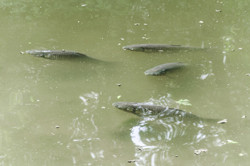New insights into pheromone pollution
Europe's most common invasive fish species, topmouth gudgeon, has impacted on the native sunbleak (in Europe) and the fathead minnow (in North America). There is a hypothesis that the topmouth gudgeon is interfering with reproduction of those species through its own pheromone signalling. This concept of pheromone pollution was the focus of the EU-funded SCENT project. Specifically, SCENT investigated whether pheromone pollution facilitated the invasiveness of topmouth gudgeon, particularly against the fathead minnow. The project spent some time establishing an experimental laboratory system of tanks and video cameras. Over a reproductive season, fathead minnows were continuously exposed to pheromones from male topmouth gudgeon. Researchers found no impact of topmouth gudgeon pheromones on fathead minnow reproduction despite a significant impact of evidence of female fathead minnow preference for topmouth gudgeon hidden sex signals. SCENT also spent some time isolating and characterising the chemical structure of these pheromones. Overall, the project contributed to scientists' understanding of pheromone pollution and invasion biology in general.
Keywords
Pheromone pollution, pheromone signalling, topmouth gudgeon, reproduction, Biological Invasion

